Trombone Mouthpiece Overview and Fitting Guide Old
Generally Happy With Your Current Mouthpiece?
If you are fairly happy with your current mouthpiece and just want to know what the Wedge design can do for your playing you can simply select a mouthpiece using one of our trombone comparison tables.
Wanting to Improve a Specific Aspect Of Your Playing?
A good first step is to assess your sound, range, and endurance.

Why do we specifically talk so much about sound, range and endurance in a fitting guide? It is because better range and endurance are the two things most players say they are looking for in a new mouthpiece. The challenge is to improve those without compromisng sound. Although they can be addressed separately, range and endurance are often linked. Many players would like to have more range when they are fresh, but range becomes an even bigger issue when we are tired. That, basically, is the definition of endurance.
You can get good information about possible ways to improve your range and endurance by doing an honest assessment of your sound. That means asking yourself if your sound quality in all registers is ideal or at least acceptable, and if your range is ideal or at least acceptable.
You can get good information about possible ways to improve your range and endurance by doing an honest assessment of your sound. That means asking yourself if your sound quality in all registers is ideal or at least acceptable, and if your range is ideal or at least acceptable.

The most common problem players report to us is a sound that is big and fat in the mid to low register, but small, strained, and limited in the upper register. Their sound is shaped like a pyramid. It has a broad base, but does not extend as high as they would like, as depicted in the "Pyramid Sound Profile" graphic. Compare the breadth of sound between the lower and upper register, and note their range.
You can see that there is an imbalance. The sound is broader than what is expected or required, and their range is not optimal or even acceptable.
You can see that there is an imbalance. The sound is broader than what is expected or required, and their range is not optimal or even acceptable.
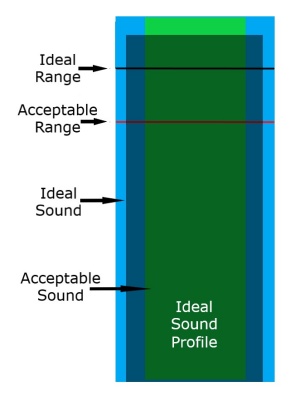
A far more desirable sound profile is shown in the "Ideal Sound Profile" graphic. The breadth of sound and range are both in the ideal range.
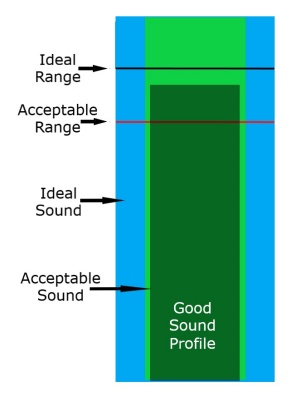
Unfortunately, there are few things that are ideal when it comes to brass playing, and especially when it comes to mouthpiece selection. Rather than playing the "perfect" mouthpiece we play the best mouthpiece possible based on a series of decisions we make and compromises we accept in the playing characteristics of a mouthpiece. Our goal should be to arrive at the best balance of sound and other playing attributes in a mouthpiece. The result is a sound profile that looks like the "Good Sound Profile" graphic.
Players switching to a Wedge mouthpiece will often get a more even response between the registers. In many cases players with a pyramid sound profile can balance their sound even more with a slightly smaller mouthpiece.
Players switching to a Wedge mouthpiece will often get a more even response between the registers. In many cases players with a pyramid sound profile can balance their sound even more with a slightly smaller mouthpiece.
What Would You Like to Improve?
I want better range and endurance without changing my sound.
Most players will get better range and endurance with a similar sound when they switch to a Wedge mouthpiece. However, range is usually more of an issue when you are tired compared to when you are fresh. For that reason a good way to get an extra boost in range is to try a mouthpiece with a similar cup depth and slightly smaller diameter.
The smaller diameter will usually increase endurance, and therefore range when tired, without having making the sound significantly brighter. A smaller diameter has more of an effect of reshaping the sound, making it a little less broad at the base and bigger at the top. Imagine changing the shape of your sound from a broad based pyramid to a narrower, but still strong based column that reaches higher.
I want a darker sound and better low register without giving up range.
A darker sound can be achieved a few difference ways:
1) Deeper Cup
2) Heavier Mouthpiece
3) Plastic Mouthpiece
Most players will get better range and endurance with a similar sound when they switch to a Wedge mouthpiece. However, range is usually more of an issue when you are tired compared to when you are fresh. For that reason a good way to get an extra boost in range is to try a mouthpiece with a similar cup depth and slightly smaller diameter.
The smaller diameter will usually increase endurance, and therefore range when tired, without having making the sound significantly brighter. A smaller diameter has more of an effect of reshaping the sound, making it a little less broad at the base and bigger at the top. Imagine changing the shape of your sound from a broad based pyramid to a narrower, but still strong based column that reaches higher.
I want a darker sound and better low register without giving up range.
A darker sound can be achieved a few difference ways:
1) Deeper Cup
2) Heavier Mouthpiece
3) Plastic Mouthpiece
1) Deeper Cup
Using a deeper cup (changing from C to AL, AL to GS, GS to G, G to D, D to XD) will produce a darker sound and bigger low register, but the upper register gets harder. For more details about trombone cup depths, scroll down farther on this page.
One way to minimize the loss of range that comes with a deeper cup is to reduce diameter at the same time. Wedge trombone rims are measured in inches at .05 inches into the cup. The rim is named according to the measurement in the long, vertical axis of the oval. For example, a 96 rim measures .96 inches, and a 101 rim measures 1.01 inches. You might change from a 1.01 inch rim and a GS cup to a 1.0 inch rim and a G cup. For example you might be playing a Bach 5GS and want a darker sound without losing range and endurance. The Wedge equivalent of the Bach 5GS is the 101GS. You could switch to the smaller ID, deeper cup 100G.
Using a deeper cup (changing from C to AL, AL to GS, GS to G, G to D, D to XD) will produce a darker sound and bigger low register, but the upper register gets harder. For more details about trombone cup depths, scroll down farther on this page.
One way to minimize the loss of range that comes with a deeper cup is to reduce diameter at the same time. Wedge trombone rims are measured in inches at .05 inches into the cup. The rim is named according to the measurement in the long, vertical axis of the oval. For example, a 96 rim measures .96 inches, and a 101 rim measures 1.01 inches. You might change from a 1.01 inch rim and a GS cup to a 1.0 inch rim and a G cup. For example you might be playing a Bach 5GS and want a darker sound without losing range and endurance. The Wedge equivalent of the Bach 5GS is the 101GS. You could switch to the smaller ID, deeper cup 100G.
2) Heavier Mouthpiece
We do not make heavy weight Wedge trombone mouthpieces. However, you can increase the mass of the mouthpiece by adding a brass tone modifier. The extra mass dampens the brighter overtones, makes slotting more secure, adds core to the sound, and makes it slightly darker.
We do not make heavy weight Wedge trombone mouthpieces. However, you can increase the mass of the mouthpiece by adding a brass tone modifier. The extra mass dampens the brighter overtones, makes slotting more secure, adds core to the sound, and makes it slightly darker.
3) Plastic Mouthpieces
Plastic mouthpieces can produce a darker sound. However plastic mouthpieces also feel sticky on the chops, which can reduce flexibility. They are easy to play softly, but the start of the note is not as clear as with a brass mouthpiece. Plastic mouthpieces do not feel as secure as brass, with less defined slotting and less core in the sound. For more details about plastic visit our Brass vs. Plastic page.
Plastic mouthpieces can produce a darker sound. However plastic mouthpieces also feel sticky on the chops, which can reduce flexibility. They are easy to play softly, but the start of the note is not as clear as with a brass mouthpiece. Plastic mouthpieces do not feel as secure as brass, with less defined slotting and less core in the sound. For more details about plastic visit our Brass vs. Plastic page.
I want more range and am happy with a brighter sound.
Getting more range with a brighter sound is usually easy. It just means trying a shallower cup, and sometimes a smaller diameter. Typical cup changes would be C to E, AL to C, GS to AL, G to AL, G to GS, GS to G, D to G, or XD to D. Wedge cup depths are similar to Bach cups.
Note: Not all diameters are available in all cup depths. If in doubt give us a call and we will be happy to help you.
Note: Depending on the type of playing you do, it often makes sense to also go to a smaller diameter when more range is desired along with a brighter sound.
Getting more range with a brighter sound is usually easy. It just means trying a shallower cup, and sometimes a smaller diameter. Typical cup changes would be C to E, AL to C, GS to AL, G to AL, G to GS, GS to G, D to G, or XD to D. Wedge cup depths are similar to Bach cups.
Note: Not all diameters are available in all cup depths. If in doubt give us a call and we will be happy to help you.
Note: Depending on the type of playing you do, it often makes sense to also go to a smaller diameter when more range is desired along with a brighter sound.
What Cup Depth Should I Choose?
Wedge E Trombone Cup

* Shallow cup similar to Bach E
* Bright sound with lots of projection
* Suitable for Alto trombone
* Preferred by some for extreme lead playing
* Bright sound with lots of projection
* Suitable for Alto trombone
* Preferred by some for extreme lead playing
Wedge C Trombone Cup

* Typical shallow C trombone cup
* Similar to Bach C cup
* Good projection
* Most effective with a small to medium diameter as beginner mouthpiece, or for lead trombone
* Similar to Bach C cup
* Good projection
* Most effective with a small to medium diameter as beginner mouthpiece, or for lead trombone
Wedge AL Trombone Cup

* Medium cup with a slightly funnel shape
* Similar to Bach 6-1/2AL cup
* Relatively dark sound from a medium cup
* Good for intermediate players and players needing something between the shallow C cup and symphonic G cup
* Similar to Bach 6-1/2AL cup
* Relatively dark sound from a medium cup
* Good for intermediate players and players needing something between the shallow C cup and symphonic G cup
Wedge GS Trombone Cup

* Intermediate between AL and G cup
* Similar to Bach 5GS cup
* Good combination of projection and lower register performance
* More upper register support and projection than the G cup
* Similar to Bach 5GS cup
* Good combination of projection and lower register performance
* More upper register support and projection than the G cup
Wedge G Trombone Cup
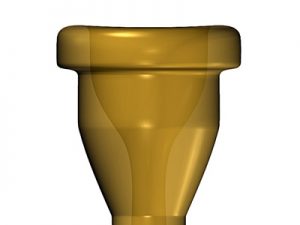
* Medium deep cup similar to Bach 5G
* Most popular model for mature players in a concert band or orchestral setting
* Well balanced sound with even response in all registers
* Works very well with larger diameters and slightly deeper cup for bass trombone
* Most popular model for mature players in a concert band or orchestral setting
* Well balanced sound with even response in all registers
* Works very well with larger diameters and slightly deeper cup for bass trombone
Wedge D Trombone Cup
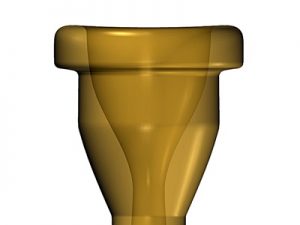
* Deeper cup for an extra full low register
* Works well for second or third trombone when a big, dark sound is required
* Well suited for bass trombone when a larger diameter is used
* Works well for second or third trombone when a big, dark sound is required
* Well suited for bass trombone when a larger diameter is used
Wedge XD Trombone Cup
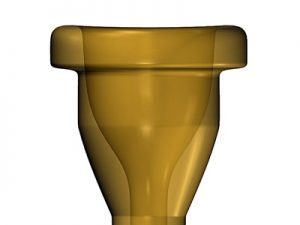
* Extra deep cup for bass trombone
* Huge sound and even response in all registers despite the deep cup
* Huge sound and even response in all registers despite the deep cup

